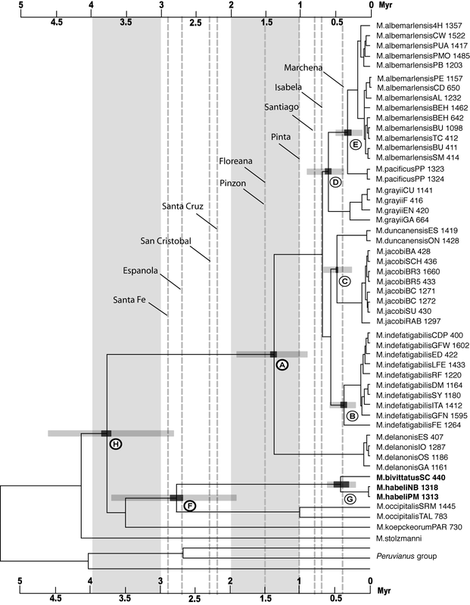Galapagos Biogeography

Galápagos sequence and tempo of colonization is a larger theme for Biogeography in general. Most organisms present in the Archipelago have effectively radiated into multiple species, and in order to understand these and other evolutionary processes, having a good understanding of both spatial and temporal contexts is key.
Species of the lizard genus Microlophus have successfully colonized the Galapagos Archipelago twice. The two events were independent from each other, happened at different times and gave origin to different monophyletic clades.
The first Galapagos colonization arrived into one of the two oldest Galapagos Islands (Espanola). The Microlophus delanonis stem age shows the possibility that this lineage is older than the estimated age of Espanola. The original colonizer radiated into several species relatively recently (1.5 My.).
The second lizard Galapagos colonization, occurred approximately a million years later into San Cristobal Island. It was less successful in that this lineage was the source of a single founder event in contrast to the 'first' colonization that led to the origin of multiple species. The clade including Microlophus bivittatus and M. habeli is sister to one extant species from from Northern Peru (M. occipitalis).
One interesting feature of the Microlophus radiation is the 'one island - one species' pattern. In the original study, we explained this pattern by advocating of competitive exclusion once one species evolves within a single island. This hypothesis, however, remains to be tested by exploring pre- and post-mating isolation mechanisms between closely and not-so closely related lizard species.
Finally, most clades of the phylogenetic reconstruction shown above are very well supported. However, we expect coalescent stochasticity to be pervasive among most 'shallow' nodes. I have recently reconstruct phylogenetic relationships while accommodating coalescent stochasticity (*BEAST), and interestingly, some of the relationships recovered through this approach are not the same, and modify the biogeographic hypothesis so far supported for Microlophus.
Species of the lizard genus Microlophus have successfully colonized the Galapagos Archipelago twice. The two events were independent from each other, happened at different times and gave origin to different monophyletic clades.
The first Galapagos colonization arrived into one of the two oldest Galapagos Islands (Espanola). The Microlophus delanonis stem age shows the possibility that this lineage is older than the estimated age of Espanola. The original colonizer radiated into several species relatively recently (1.5 My.).
The second lizard Galapagos colonization, occurred approximately a million years later into San Cristobal Island. It was less successful in that this lineage was the source of a single founder event in contrast to the 'first' colonization that led to the origin of multiple species. The clade including Microlophus bivittatus and M. habeli is sister to one extant species from from Northern Peru (M. occipitalis).
One interesting feature of the Microlophus radiation is the 'one island - one species' pattern. In the original study, we explained this pattern by advocating of competitive exclusion once one species evolves within a single island. This hypothesis, however, remains to be tested by exploring pre- and post-mating isolation mechanisms between closely and not-so closely related lizard species.
Finally, most clades of the phylogenetic reconstruction shown above are very well supported. However, we expect coalescent stochasticity to be pervasive among most 'shallow' nodes. I have recently reconstruct phylogenetic relationships while accommodating coalescent stochasticity (*BEAST), and interestingly, some of the relationships recovered through this approach are not the same, and modify the biogeographic hypothesis so far supported for Microlophus.
